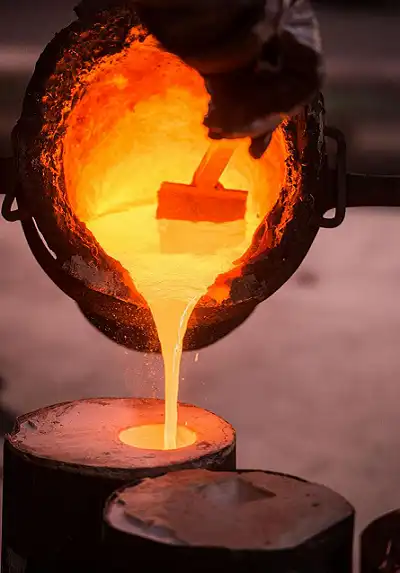
Knowledge
Control of the Purity of Molten Iron for High-strength and High-toughness Cast Iron

The traditional concept of purity of molten iron in cast iron focused on "reducing impurity content", but in the context of high-strength and high-toughness cast iron, this idea has become limited. Modern research shows that the essence of purity is "precise control of impurities" - certain elements or inclusions, in specific forms and distributions, can become "functional units" for performance optimization. This paper, based on the latest research, redefines the purity of molten iron and proposes control strategies for engineering implementation.
I. New Definition of Purity of Cast Iron Molten Iron
1. Paradigm Shift from "Reducing Impurities" to "Controlling Impurities"
Traditional Definition: Pursuing low sulfur (S ≤ 0.02%), low phosphorus (P ≤ 0.05%), and low oxygen (O ≤ 30 ppm).
New Definition: Aiming for a balance between "performance and cost", achieved through "functionalization of impurities":
Beneficialization: Utilizing trace elements (such as Sb, Sn) to stabilize pearlite and enhance strength (tensile strength ≥ 800 MPa).
Harmlessness: Eliminating hazards through morphology control (such as passivation of sulfides).
Synergization: Designing the interaction between impurities and the matrix.
2. Core Requirements for High-Strength and High-Toughness Cast Iron
Graphite Morphology Control: A-type graphite proportion ≥ 90%, avoiding D-type/E-type graphite to prevent brittleness.
Matrix Strengthening: Achieving multiphase structure through trace alloying.
Fatigue Resistance Design: Controlling inclusion size ≤ 20 μm to reduce stress concentration factor.
II. Engineering Practice of Impurity Functionalization Design
1. The "Double-Edged Sword" Nature of Sulfur (S) and Its Control
Traditional Understanding: Sulfur reacts with magnesium to form MgS, consuming the spheroidizing agent, and thus its content must be strictly limited (S ≤ 0.02%).
New strategy:
Utilize residual sulfur (0.015% to 0.025%) to reduce the superheat of magnesium treatment and decrease the tendency of shrinkage porosity.
Add 0.1% to 0.3% calcium (Ca) to passivate MnS inclusions and enhance cutting performance (tool life +40%).
2. "Smart Purification" of Rare Earth Elements (RE)
Mechanism of Action:
Purification: RE combines with oxygen and sulfur to form high-melting-point RE₂O₂S, reducing slag adhesion to the furnace (reducing residual slag by 30%).
Modification: RE adsorbs on the growth interface of graphite, promoting the nucleation of spherical graphite (increasing spheroidization rate to 95%).
Engineering parameters: RE addition amount 0.005% to 0.015%.
3. Nitrogen (N) Intercstitial Strengthening and Porosity Inhibition
Application in high-strength gray cast iron: Control N content at 80~150 ppm.
Strengthening: Nitrogen dissolves in ferrite, increasing hardness (HB increases by 10~15 points).
Preventing porosity: Add 0.01%~0.03% titanium (Ti), which forms TiN as a nucleation base for bubbles, reducing subsurface porosity.
III. Key Technologies for Controlling the Purity of Molten Iron
1. Refinement of Raw Materials
Sorting of Scrap Steel: Use X-ray fluorescence sorting (XRF) for scrap steel to distinguish types and grades.
Clarify the source and origin of pig iron and determine the composition or content of trace elements.
Use carbon additives and silicon carbide with clear and reliable components and properties.
2. Innovation in Melting Process
Optimization of Double Melting:
Pre-melting in medium-frequency furnace: Rapidly heat up to 1500℃, increasing phosphorus removal efficiency by 50%.
Insulation in power-frequency furnace: Maintain a constant temperature of 1450℃ ± 10℃ for 20 minutes to facilitate the floating of inclusions.
Use of silicon-barium composite deoxidizer (BaSi₃), with real-time adjustment of the dosage (oxygen activity controlled at 10 - 15 ppm).
3. Intelligent Monitoring System
Online Spectroscopic Analysis: Detects the contents of C, Si, and Mn every 5 minutes (with fluctuation control within ±0.05%).
Inclusion Warning Model: Based on big data, it establishes a mapping of "melting parameters - inclusion grade" to warn of over-limit risks 30 minutes in advance.
IV. Conclusion and Outlook
The newly defined value of molten iron purity: shifting from a "purity competition" to "functional design" offers a new path for the development of high-strength and high-toughness cast iron.
Action guidelines:
Establish a "composition-process-inclusions-performance" database to achieve precise control.
Promote interdisciplinary cooperation (such as computational materials science + casting technology) to break through the limitations of experience.
The new understanding of molten iron purity is not only a technological upgrade but also a leap in thinking mode - from "eliminating defects" to "designing defects", from "passive control" to "active creation". Only by changing our perception can we achieve greater breakthroughs in the innovation of high-end cast iron parts.



